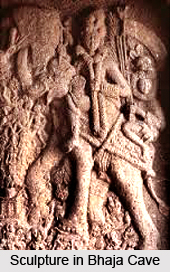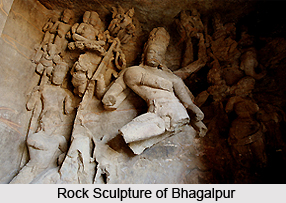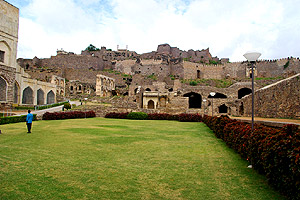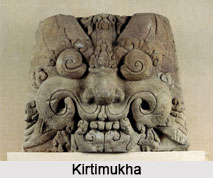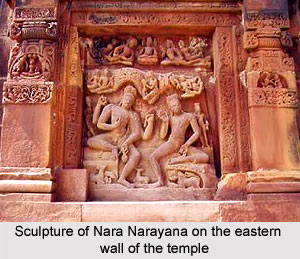 The sculpture of Vishnu temple of Deogarh is a grand example of the Hindu architecture of the Gupta period. It probably dates from the fifth century AD. The carving of the frame complements the richness of the reliefs. The voluptuous grace of the figures and the already recognisable metaphorical conventions of anatomy and features strike a chord to us of the style of Gupta Buddhist sculpture at Sarnath but the elegance and dramatic conception of relief are far more poignant than anything to be found in Buddhist art of the fifth and sixth centuries.
The sculpture of Vishnu temple of Deogarh is a grand example of the Hindu architecture of the Gupta period. It probably dates from the fifth century AD. The carving of the frame complements the richness of the reliefs. The voluptuous grace of the figures and the already recognisable metaphorical conventions of anatomy and features strike a chord to us of the style of Gupta Buddhist sculpture at Sarnath but the elegance and dramatic conception of relief are far more poignant than anything to be found in Buddhist art of the fifth and sixth centuries.
Originally the temple platform was adorned with a continuous fresco illustrating events from the epic Ramayana, which was a popular text during the Gupta times for its heroic description of the conquest of a godly race. The main doorway of the temple at Deogarh serves as an example of the extremely ornate type of portal. The projecting lintel-cornice is a feature that was found in almost all temple entrances. The main motif here consists of luxuriantly ornamented pilasters, alternately square, octagonal, and sixteen-sided in section, supporting an architrave in the shape of an extended vesara or chaitya roof decorated with chaitya dormers. Within this structure there are narrow vertical bands of decoration with depiction of auspicious couples. And in the centre of the over-door slab is a plaque of Lord Vishnu on the great Naga. Around the frame of the doorway are panels with crisply carved foliate details. This is a motif that occurs repeatedly in this arrangement in the buildings of Gupta times. At the bases of the overlapping frames of the door are carvings of female divinities.
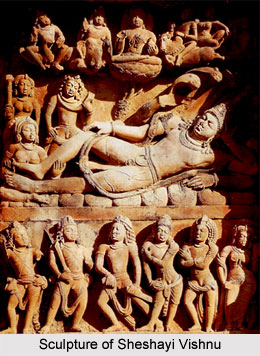 Sculpted panels are seen on the terraced basement, with carved figurines of river goddesses Ganga and Yamuna. They are placed near the next to the doorway to the sanctum sanctorum. On the side walls there are three large carved panels of Vaishnava mythology related to Gajendra Moksha, the Nara Narayana Tapasya (meditation), and the Sheshashayi Vishnu (reclining on the serpent), are illustrated. In the sculpture of Sheshashayi Vishnu, Vishnu is depicted reclining on the serpent Shesha, with four-arms lying down on the spiral of a serpent with seven hoods. It forms a shade over his crowned head. Goddess Lakshmi along with her two attendants, are at the feet of Lord Vishnu. In another panel two demons, Madhu and Kaitabha are about to attack. They are repulsed by the four personified weapons of Vishnu. The lower panel depicts five Pandavas and their wife Draupadi. The relief on the doorway again depicts Vishnu seated on Shesha the serpent, with Lakshmi sitting down and caressing his feet, flanked by two incarnations of Vishnu: Narasimha (the man-lion form) on the right and Vamana avatar (the dwarf form) on the left.
Sculpted panels are seen on the terraced basement, with carved figurines of river goddesses Ganga and Yamuna. They are placed near the next to the doorway to the sanctum sanctorum. On the side walls there are three large carved panels of Vaishnava mythology related to Gajendra Moksha, the Nara Narayana Tapasya (meditation), and the Sheshashayi Vishnu (reclining on the serpent), are illustrated. In the sculpture of Sheshashayi Vishnu, Vishnu is depicted reclining on the serpent Shesha, with four-arms lying down on the spiral of a serpent with seven hoods. It forms a shade over his crowned head. Goddess Lakshmi along with her two attendants, are at the feet of Lord Vishnu. In another panel two demons, Madhu and Kaitabha are about to attack. They are repulsed by the four personified weapons of Vishnu. The lower panel depicts five Pandavas and their wife Draupadi. The relief on the doorway again depicts Vishnu seated on Shesha the serpent, with Lakshmi sitting down and caressing his feet, flanked by two incarnations of Vishnu: Narasimha (the man-lion form) on the right and Vamana avatar (the dwarf form) on the left.
The side and back walls of the temple portray several aspects of Lord Vishnu`s life. On the northern wall "Gajendra Moksha" is depicted that represents Vishnu coming to the rescue of the Gajendra. On the eastern wall, a panel depicts a carved image of the sages Nara-Narayana. On the southern wall, Vishnu is depicted reclining on Shesha the serpent, relaxing or in a sleeping mode.
The entrance represents Vasudeva; the Gajendramoksha side is referred as Samkarshana, the destructive aspect of Vishnu; the Nara-Narayana side is the preserving aspect of Vishnu and the Anantashayana side is called Aniruddha.
